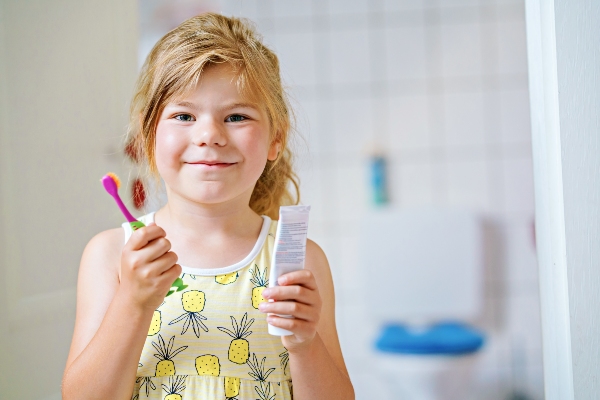5 Frequently Asked Questions About Dental Fillings for Kids

As dental professionals, we often receive questions about dental fillings for kids. We are glad to answer because caregivers who have more information about dental procedures are in a position to make better oral care decisions for their children. This guide answers a few of the most common questions that parents and guardians have.
Answers to common questions about dental fillings for kids
Here are the answers to frequently asked questions from parents about dental fillings for kids. Specifically, we discuss the symptoms of tooth decay, dental filling material options, the placement process, and whether dental fillings for kids are necessary.
What are the signs of a dental cavity?
The earlier that parents can identify a pediatric dental cavity, the less invasive the treatment will likely be. For this reason, parents need to know the earliest signs of a dental cavity and check their child’s teeth often (such as each night while helping them brush). Ideally, parents will be able to identify weakened enamel, which is reversible. The signs include discolored enamel (usually a whiter shade that develops when the enamel begins to break down) and tooth sensitivity. If left untreated, weakened enamel can worsen into a cavity, which is irreversible and requires restorative treatment. The signs of cavity formation include:
- Tooth discoloration
- Toothache
- Tooth sensitivity
- Visible hole on one or more teeth
Cavities can form on any tooth. It is easy to identify cavities on the visible surfaces of teeth, but the less-visible areas, such as the grooves of molars and premolars, are often the most vulnerable to cavities. It is essential to check all locations and ensure that the child adequately brushes these hard-to-reach surfaces.
What are the different types of dental filling materials for kids?
A pediatric dentist may recommend several different types of dental filling materials. The tooth's location, the patient's age, and personal preference all play a role in determining which option is best. The most popular types are:
- Composite filling: This is a tooth-colored filling that is comprised of composite resin. It is the least noticeable option and ideal for more visible teeth surfaces.
- Amalgam (silver) filling: This filling option is made of metals like silver, copper, tin, and mercury. They are strong and ideal for molars and premolars that are more vulnerable to chips and cracks.
- Gold fillings: This is a less common option that uses gold and various metals. They have a high durability rating but do not blend in with natural teeth.
What is the placement process for dental fillings for kids?
The process can vary for each dentistry, but the general steps for dental fillings for kids are the same. The process usually goes as follows:
- A numbing agent is applied to minimize sensitivity and discomfort.
- The dentist cleans and disinfects the cavity using a drill or another specialized tool.
- The decayed portion of the tooth is removed.
- The dentist fills the cavity with either composite resin, amalgam, gold, or an alternative filling material.
- Then, the dentist polishes the filling and makes any necessary adjustments to ensure optimal comfort.
- For composite fillings, the dentist will need to harden the material with a special curing light.
- The dentist provides aftercare instructions to ensure a fast and smooth recovery.
Are dental fillings necessary for baby teeth?
Dental fillings are necessary for baby teeth with cavities to ensure the optimal development of permanent teeth and to avoid excessive discomfort for the child. In some cases, an alternative form of cavity treatment may be required, such as a baby root canal, dental crown, or tooth extraction. However, it is always essential to seek treatment for childhood cavities.
How can I protect my child’s teeth from cavities?
The ultimate goal is to prevent childhood cavities in the long term. This can be accomplished through regular cleaning visits, a consistent and high-quality oral care regimen that involves brushing several times a day and flossing daily, and limiting the consumption of sugar and other carbohydrates.
Reliably treat your child’s dental cavities with dental fillings for kids
You can restore your child’s oral health with dental fillings in as little as one visit. Our practice takes great pride in offering a kid-friendly atmosphere. We seek to make every child feel comfortable and have a good experience while minimizing the invasiveness of restorative procedures. Contact us today to schedule a visit. We would be happy to help!
Request an appointment here: https://www.grandparkwaypediatricdental.com or call Grand Parkway Pediatric Dental at (832) 579-0960 for an appointment in our Richmond office.
Check out what others are saying about our services on Yelp: Read our Yelp reviews.
Recent Posts
Dental fillings for kids are crucial in preventing many dental issues. Baby teeth can develop cavities. Correcting this problem is important for developing permanent teeth. Here are the details on how preventive dentistry uses dental fillings for kids.Research shows that many school-age kids suffer from cavities. This disease is common even if it is preventable.…
Dental fillings for kids are one of the most common treatments for tooth decay in children. The earlier tooth decay is detected in a child’s tooth, the easier it is to treat. Let us examine why treating childhood tooth decay is crucial and how a pediatric dentist treats it.According to the Centers for Disease Control…
Dental fillings for kids can be nerve-wracking for some kids, likely due to the necessary tools. While we aim to make this simple process as smooth and painless as possible, we need your help. Getting a firm grasp on what your kids can expect during this procedure and how to prevent a future need for…
Getting dental fillings for kids can help improve your child’s dental health. It can restore the affected teeth and relieve your child’s pain. Understanding the process can help you prepare your child for the next appointment. Here are the details on what parents like you must know about dental fillings for kids.The dentist will discuss…


